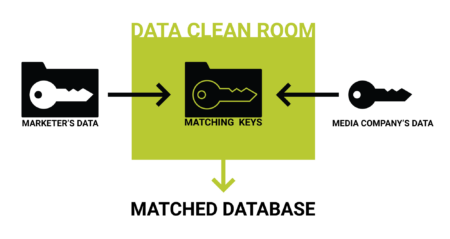The advertising industry is going through a paradigm change, transitioning to a model in which audience data is currency. But with Google joining Apple (Safari) and Mozilla (Firefox) discontinuing support for third-party cookies in Chrome, we are on the verge of losing the precision we formerly depended on to estimate the return on advertising expenditure.
Advertisers will continue to access and use first-party data, but matching data across networks will be considerably more difficult. Rather than the cross-platform perspective afforded by third-party cookie monitoring, it will rely on deeper analysis in each platform.
This where the data clean rooms concept come into play:
What exactly is a Data Clean Room?
A data cleanroom is software that allows marketers and brands to match user-level data without disclosing any personally identifiable information (PII) or raw data.
In a cookieless world, data clean rooms, where walled gardens share aggregated data without compromising privacy, are especially essential since brands have far more to contend with than the global privacy laws and data verification requirements that attract advertisers in the first place.
Data clean rooms use by big advertising platforms such as Facebook, Amazon, and Google to offer marketers matching data on the success of their ads on their platform.
All data cleanrooms have strict privacy measures that prevent firms from viewing or retrieving any customer-level data.

Advertisers gain from a better view of ad performance within each platform. However, to conduct any substantial matching with platform data requires a robust bank of first-party data in the first place.
Google Ads Data Hub, for example, lets you assess paid media performance and submit your first-party data. You may use this to segment your audiences, analyze reach and frequency, and test various attribution models.
Challenges and Limitations of Data Clean Rooms:
Complying with privacy rules and maintaining user permission is easier with first-party data (the type used to power data clean rooms). However, first-party data is far tough to obtain than third-party cookie data.
It implies that “walled gardens” like Google, Facebook, and Amazon, which have access to the most consumer data, will gain from providing marketers with improved measuring solutions.
Furthermore, companies with access to a vast amount of customer data – such as direct-to-consumer brands – would have a marketing edge over brands with no direct ties with consumers.
Today, most data clean rooms can only work for one platform (for example, a Google or Facebook platform) and can not implement in conjunction with others.
It is limiting if advertise across numerous platforms since you cannot connect the data to get a complete perspective of the customer journey without manually sewing the insights together.
Before marketers dig into a specific cleanroom platform, they should examine how much their ad spend is allocated to each network.
If, for example, you spend the majority of your digital budget on Facebook or other platforms other than Google, then exploring Google Ads Data Hub is probably not worth it.
Follow and connect with us on Facebook, LinkedIn & Twitter

